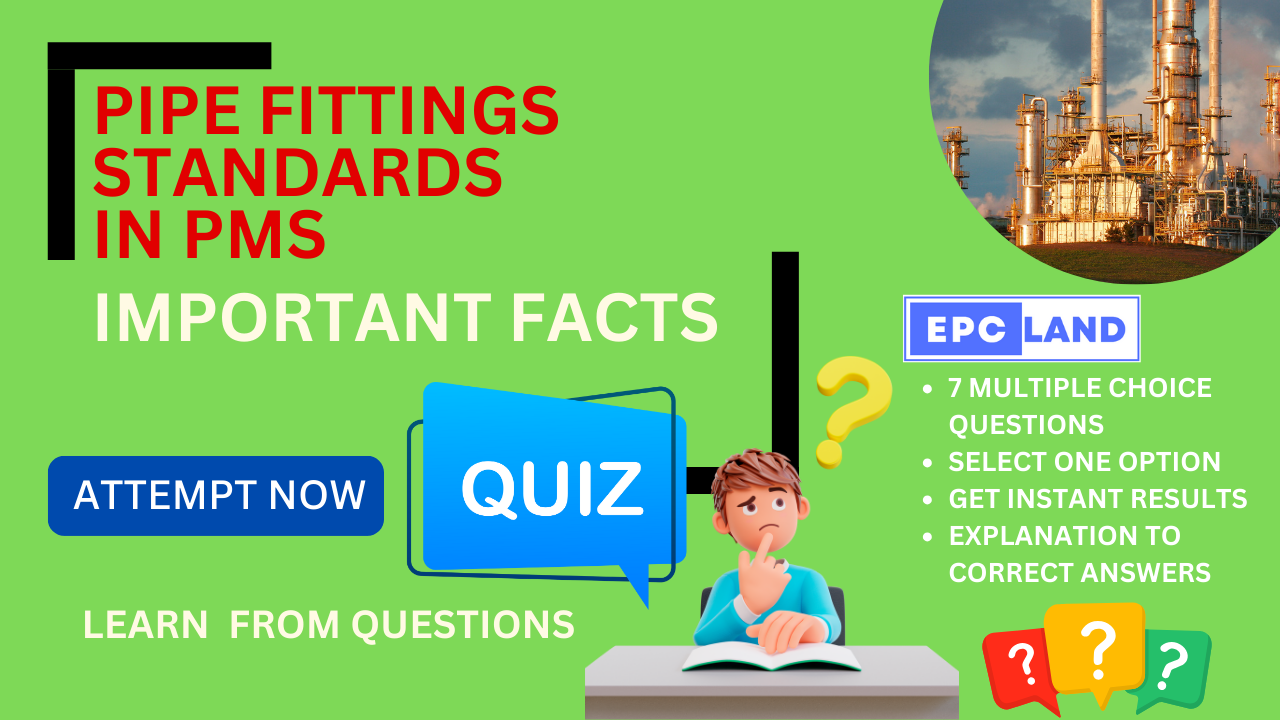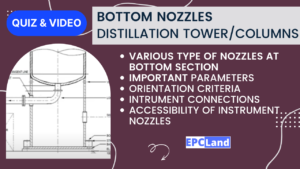I. Pipe Fittings Standards
According to the specified standards, which fittings shall be in accordance with ASME B16.11?
Explanation: Forged steel SW and threaded fittings shall be in accordance with ASME B16.11.
II. Butt Welding Fittings
What standard should be followed for BW (Butt Welding) fittings?
Explanation: Dimensions of steel BW fittings not covered in ASME B16.9 shall conform to MSS-SP-48.
III. Usage of Unions
According to the specified standards, when is the usage of unions restricted?
Explanation: The usage of unions shall be restricted to utilities only.
IV. Elbow Selection
Which type of elbow (ASME B 16.9) should be used as the default?
Explanation: Long radius butt welding elbows (ASME B 16.9) should be used as the default.
V. Unions Usage Conditions
Under what conditions is the usage of unions limited, as defined in ASME B31.3?
Explanation: The usage of unions is limited to fluid service, which is non-flammable, nontoxic, and not damaging to human tissues as defined in ASME B31.3; then design temperature is below 186 °C; the design pressure is not higher than 150 psig.
VI. Forged Steel Fittings
Which standards should be followed for Forged steel SW and threaded fittings?
Explanation: Forged steel SW and threaded fittings shall be in accordance with ASME B16.11, unless otherwise specified. For items not covered under B16.11, reference may be made to BS 3799 or appropriate MSSSP Standard.
VII. Butt Welding Elbow Criteria
Under what circumstances shall short radius elbow be used?
Explanation: Short radius elbow shall only be used when specified on the drawings.
Table of Contents
Don’t miss the Course on Effective Isometrics Management: Check Now
Enrollment Link
Recommended courses (Published on EPCLand)
- Complete Course on Piping Engineering
- Basics of Piping Engineering
- Piping Layout Engineering
- Piping Material Engineering
- Piping Stress Analysis
- Material Requisitions
- Piping Material Specifications
- Valve Material Specifications
- Plant Design & Layouts-OISD 118
- Isometric Management
Library of Technical Articles
Don’t miss out the collection of 15+ articles on following topics:
- Basics of Oil and Gas Industry
- Valves
- Testing
- Tank
- Piping Bulk Items
- Pipe
- Metallurgy
- Piping Materials
- Layout
- Instrumentation
- Heat Exchanger
- Type of Contracts
- Codes and Standards
- ASTM Standards
- Articles on Piping Specialty Items
Video details of Complete Course on Piping Engineering
Why Enroll in the EPCLand
Proven Track Record– PTR
Activities & Achievements before launching EPCLand
- Published more than 50+ short courses
- 3000+ Enrolments
- More than 3,500,00 Minutes of watch hours in the last 2 years
- 4000+ Students in 100+ Countries
- Rating of 4+ out of 5
- 1000+ YouTube Videos
- 8K+ Subscribers
What Students will Learn
- Codes & Standards of the Energy Sector
- Piping Material Engineering
- Piping Layout Engineering
- Stress Analysis
Interesting facts
- All the published courses have been developed by Industry Experts with more than 2 decades of experience
- Content is based on Practical experience and real-time problems.
- Content is designed and organized in such a manner that it can be easily grabbed.
- Complete website, Blogs and Quiz sections are Planned, Designed and published by myself (About me: Atul Singla)
- Complete flexibility of Time & Location, Students can access the content from anywhere & anytime
- Moreover, once enrolled, the content can be access as many times as you want, which helps in understand the fundamentals in a better way.
Conclusion
In conclusion, our courses are meticulously crafted by industry experts with over two decades of hands-on experience. The content is rooted in practical knowledge, addressing real-time problems. The material is thoughtfully designed and organized for easy comprehension. Every aspect, from the website to blogs and quizzes, has been planned, designed, and executed by Atul Singla, ensuring a comprehensive and seamless learning experience. With the flexibility of accessing the content at any time and from any location, students have the freedom to learn on their terms. Furthermore, enrollment grants unlimited access, allowing learners to revisit the material as often as needed, fostering a deep understanding of the fundamentals.


